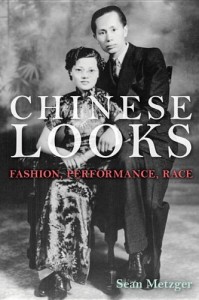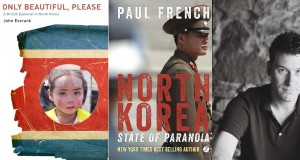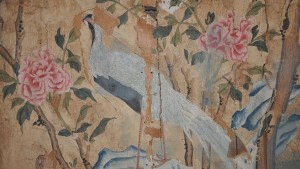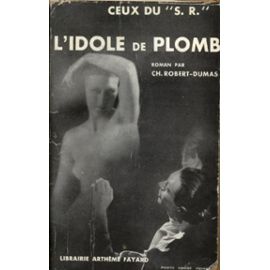Posted: May 9th, 2014 | No Comments »
Dr Julia Lovell
Birkbeck, University of London
Â
Â
Â
“The Uses of Foreigners in Communist Chinaâ€
Friday 9 May 2014 at 5.30pm
Â
Gustave Tuck Lecture Theatre
University College London
Julia Lovell is senior lecturer in modern Chinese history and literature at Birkbeck College, University of London. She is the author of three books on modern China, most recently The Opium War: Drugs, Dreams and the Making of China (2011), which won the 2012 Jan Michalski Prize. Her several translations of modern Chinese fiction include Han Shaogong’s A Dictionary of Maqiao (winner of 2011 Newman Prize for Chinese Literature), Zhu Wen’s I Love Dollars, Zhang Ailing’s Lust, Caution and Lu Xun’s The Real Story of Ah-Q, and Other Tales of China. She is currently working on a global history of Maoism, and on a new, abridged translation of Journey to the West.
Posted: May 8th, 2014 | No Comments »
Chinese Looks covers everything from Yellow Face to qipaos….

From yellow-face performance in the 19th century to Jackie Chan in the 21st, Chinese Looks examines articles of clothing and modes of adornment as a window on how American views of China have changed in the past 150 years. Sean Metzger provides a cultural history of three iconic objects in theatrical and cinematic performance: the queue, or man’s hair braid; the woman’s suit known as the qipao; and the Mao suit. Each object emerges at a pivotal moment in US-China relations, indexing shifts in the balance of power between the two nations. Metzger shows how aesthetics, gender, politics, economics, and race are interwoven and argues that close examination of particular forms of dress can help us think anew about gender and modernity.
Posted: May 7th, 2014 | No Comments »
Asia House Bagri Foundation Literature Festival
John Everard – Only Beautiful Please: A British Diplomat in North Korea
Paul French – North Korea – State of Paranoia
With Charles Scanlon – the BBC’s East Asia Editor

North Korea is a country that continues to make headlines – arousing curiosity and fear in equal measure. Former British diplomat in Pyongyang John Everard and East Asia expert French share their experiences in the country and address important questions about its uncertain future.
John Everard was the British Ambassador in North Korea from 2006 to 2008. While there he dealt with issues such as the 2006 missile and nuclear tests, North Korea’s food shortages, economic problems, and its complex politics. From 2010-11 he was a Pantech Fellow at Stanford University’s Walter H. Shorenstein Asia-Pacific Reseach Centre, where he conducted research and participated in major international conferences on North Korea. From 2011-12 he was coordinator of the UN Panel of Experts on sanctions against North Korea. His distinguished career with the Foreign and Commonwealth Office covered 30 years, spanned four continents, and included other politically sensitive posts such as Ambassador to Belarus and Ambassador to Uruguay. His experiences in North Korea are chronicled in his book Only Beautiful, Please: A British Diplomat in North Korea.
Paul French has lived and worked in China for many years. He is a widely published analyst and commentator, contributing to the China Economic Review, the East Asia Forum Quarterly, Foreign Policy, the Asian Wall Street Journal and other publications. He is the author of Midnight in Peking and the series editor of Zed Books’ Asian Arguments series and the Royal Asiatic Society-Hong Kong University Press China Monographs.
They will be speaking to Charles Scanlon, BBC’s East Asia Editor. He was BBC Korea correspondent from 1994-97 and Japan and Korea correspondent from 2000-07.
7 May 2014 18:45
Asia House
63 New Cavendish St London, W1G 7LP
Booking – click here

Posted: May 6th, 2014 | No Comments »
The discovery of eighteenth century Chinese wallpaper buy conservators at Woburn Abbey is now the subject of an exhibition…Peeling Back the Years. The exhibition covers Woburn’s two distinct periods of Chinoiserie in both the house and garden. The recently discovered mid-18th century wallpaper fragments in the family, private and State apartments were amongst the earliest Chinese wallpapers made for the European market, and have not been seen since these rooms were redecorated in the late-18th/early-19th centuries. The second wave of Chinoiserie decoration in the early-19th century shows how taste and designs changed.
More on the long lost wallpaper here

Chinese white male pheasant on a rock amongst tree peonies; detail from Chinese wallpaper, 1752
Posted: May 5th, 2014 | No Comments »
I’ve blogged here about Yellow Peril fiction before, mostly British, but here’s a French Yellow Peril genre shocker that’s been largely forgotten but that does show how long running the genre was. Charles Robert-Dumas’s 1935 novel L’idole de Plomb (The Lead Idol) concerns a Mongolian who just happens to be a Bolshevik agent, a thug and a political fanatic. His specialty is slicing open the bellies of his adversaries in Paris hotel rooms. He’s ruthlessly stealing French military secrets to sell to the Germans and just happens to also be a chemist and inventor of a vapour (miasmic yellow clouds of death images invoked here!) called (presciently given 1990s drug culture) “Ecstasy 136”. It’s a neat little chemical as it can either kill the entire population of Paris or work as an aphrodisiac on any woman he chooses. Fortunately he hs a weakness – beautiful French women – and one, a French agent, manages to blow his brains out before he can destroy Paris. Yellow Peril and gas often go together in the genre – silent, deadly, fiendish and recently used to terrifying effect in the trenches of World War One.
L’idole de Plomb is a pretty rubbish novel, even by the pretty low standards of the genre but it apparently shifted 27,000 copies in 1935 France, but then it did have some tits on the cover!

Posted: May 3rd, 2014 | No Comments »
‘Rage, rage against the dying of the light.’ It’s the centenary of Dylan Thomas’s birth, a favourite poet of mine ever since I was given a copy of Under Milk Wood as a young lad. I didn’t think I’d be able to work Thomas into this blog but it turns out that, as a boy, as a boy, in Swansea he did dream of China….
Dylan Thomas from Quite Early One Morning:Â
         “I was born in a large Welsh town at the beginning of the Great War—an ugly, lovely town (or so it was and is to me), crawling, sprawling by a long and splendid curving shore where truant boys and sandfield boys and old men from nowhere, beachcombed, idled and paddled, watched the dock-bound ships or the ships streaming away into wonder and India, magic and China, countries bright with oranges and loud with lions; threw stones into the sea for the barking outcast dogs; made castles and forts and harbours and race tracks in the sand; and on Saturday afternoons listened to the brass band, watched the Punch and Judy, or hung about on the fringes of the crowd to hear the fierce religious speakers who shouted at the sea, as though it were wicked and wrong to roll in and out like that, white-horsed and full of fishes.”
Posted: May 3rd, 2014 | 1 Comment »
  RAS WEEKENDER
SPENCER DODINGTON will lead a walking tour of
Architect Paul Veysseyre’s Historic Art Deco Buildings.

Â
1:30pm (2pm start) – 4pm
venue TBA
PRIORITY TO RAS MEMBERS
Paul Veysseyre was a leading French architect who lived in Shanghai from 1921 to 1937, one of the principles of the architectural firm Leonard, Veysseyre & Kruze. Over a hundred of his buildings are still standing in Shanghai, contributing to the city’s extremely diverse architectural heritage. Well-known works include the Cercle Sportif Français (now the Okura Garden Hotel), the Boissezon Apartments and the Dauphine Apartments, just to name a few.
Â
In this 2-hour guided walk, Spencer Dodington will lead RAS members and friends around parts of the Former French Concession to view some of Veysseyre’s work. Spencer is the author of Paul Veysseyre: Shanghai’s Art Deco Master, which chronicles the architect’s life and works.

Â
Spencer Dodington is an expert on the history and restoration of Shanghai Art Deco architecture. His work in the city has been chronicled in magazines and newspapers around the globe. He lives and works in Shanghai.
Â
Â
It took Spencer Dodington and Charles Lagrange three years of researching and writing, using original and new photos, to finally give readers a close-hand account of Veysseyre’s life. The book is not only the first comprehensive book about him, it is also the only recent book in English offering a succinct history of the French Concession and its legacy. Part of this legacy is the city’s Art Deco image, due to Veysseyre.
Â
In her foreword for the book, Tess Johnston writes: “Spencer Dodington and Charles Lagrange are the perfect choice to document Veysseyre’s life and work… Anyone who loves architecture in all its variety – and wants to understand how it evolved – will find this volume illuminating.”
RSVP: to RAS Bookings at: bookings@royalasiaticsociety.org.cn
Â
ENTRANCE: Members 100 RMB – Non Members 150 RMB
Â
Copies of the book, Shanghai’s Art Deco Master, Â will be available for sale (cash purchase only – 350 RMB) at the end of the Walk.
Â
Priority for RAS members. maximum of 20 participants. Those unable to make the donation but wishing to attend may contact us for exemption.
Posted: May 1st, 2014 | 3 Comments »
Back in July 2011 I blogged about the writer WG Sebald, who in his masterpiece of travel writing The Rings of Saturn tells of a train, once belonging to the Guangxu emperor, that had been brought home and ran on a small line in Suffolk – the full story from Sebald here and some film of the old train concerned here. Well, apparently it’s a bogus tale. A regular China Rhymer contacted me to inform that Ransome and Rapiers, the manufacturers of the train, never exported any trains to China and that they never made any trains that would fit Chinese rail gauges – so that’s that lovely tale blown out of the water. Ho hum….
But here anyway is an undated picture of the Chinese Imperial train all decked out and running on the small line that followed the Tartar Wall around Peking (which I’ve blogged about here, way back in 2008)









